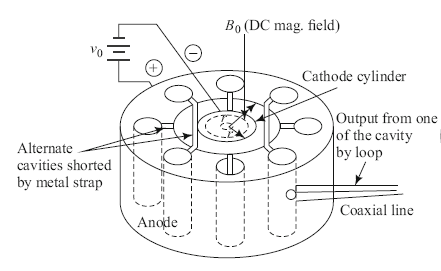Table of Contents
Definition of Two Cavity Klystron and TWT Amplifier
Two Cavity Klystron
A two-cavity klystron amplifier is shown in the figure. Two cavity klystron is basically a velocity modulated tube. Here input cavity is called buncher and output cavity is called catcher. The anode is kept at a positive potential with respect to the cathode. The electron beam passes through a gap ‘A’ which consist of two grids of the catcher cavity with a small gap ‘B’. The input and output are taken from the tube via resonant cavities with the help of coupling loops. The anode is kept at a positive potential with respect to the cathode. The electron beam passes through a gap ‘A’ which consist of two grids of the catcher cavity with a small gap ‘B’. The input and output are taken from the tube via resonant cavities with the help of coupling loops.
Travelling wave tube (TWT)
Travelling wave tube is basically an amplifier which makes use a distributed interaction between travelling wave and electron beam. It is necessary for interaction that they are both travelling in the same direction with the same velocity. The interaction between RF filed and moving electrons will take place only when the velocity of RF fields is retarded by some means. This is achieved by a slow-wave structure.
Difference Between TWT and Two Cavity Klystron
| Property/function | Travelling wave tube Amplifier (TWTA) | Two-cavity klystron amplifier |
| 1. Resonator | Conventional resonator does not exist and hence has a non-resonant µw circuit. However, each of the helix can be treated as a cavity | It has two cavities as resonators |
| 2. EM-field and e-beam | ‘e’-beam bunches travel in synchronous with field/wave current which is the helix | e-beam bunches travel but field wave is stationary in the two cavities |
| 3. Input and output | The two ends of helix are used for the input signal and amplified output signal | The two independent separator cavities are for input and output |
| 4. Energy transfer | Interaction and energy transfer from e-beam to EM. Wave in helix is continuous over the whole of its length of 12″ | Energy transfer is only in the two cavities, i.e., cavity-1 to e-beam and then e-beam to cavity-2 as output |
| 5. Slow-wave structures for synchronizing the two velocities | The high-speed EM wavefield current in helix (of velocity ‘e’) needs to be synchronized. Therefore, its path is increased by having it helical, for keeping its pace with linearly moving e-beam | No such requirement here |
| 6. e-beam bunching | It takes place all along the length | Also all along the length |
| 7. Tuning and the frequency band of a given design or model | Each of the helix can be treated as a cavity. Therefore, it can be used over a very wide frequency band is a non-resonant circuit device | For tuning, the frequency of the two cavities has to change together, which is impossible. Therefore, tuning is ±10% only, that too at the cost of gain |
| 8. Gain | 50–60 dB | 15–70 dB |
| 9. Efficiency | 10–20% (near 3 GHz) | 30–40% |
| 10. Life | Very long life up to 50,000 h | Much lower life than TWTA |




